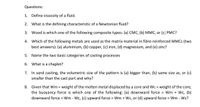
Elements Of Electromagnetics
7th Edition
ISBN: 9780190698614
Author: Sadiku, Matthew N. O.
Publisher: Oxford University Press
expand_more
expand_more
format_list_bulleted
Concept explainers
Question

Transcribed Image Text:Questions:
1. Define viscosity of a fluid.
2. What is the defining characteristic of a Newtonian fluid?
3. Wood is which one of the following composite types: (a) CMC, (b) MMC, or (c) PMC?
4. Which of the following metals are used as the matrix material in fibre-reinforced MMCS (two
best answers): (a) aluminium, (b) copper, (c) iron, (d) magnesium, and (e) zinc?
5. Name the two basic categories of casting processes
6. What is a chaplet?
7. In sand casting, the volumetric size of the pattern is (a) bigger than, (b) same size as, or (c)
smaller than the cast part and why?
8. Given that Wm = weight of the molten metal displaced by a core and Wc = weight of the core,
the buoyancy force is which one of the following: (a) downward force = Wm + Wc, (b)
downward force = Wm - Wc, (c) upward force Wm + Wc, or (d) upward force Wm - Wc?
%3D
Expert Solution
This question has been solved!
Explore an expertly crafted, step-by-step solution for a thorough understanding of key concepts.
This is a popular solution
Trending nowThis is a popular solution!
Step by stepSolved in 2 steps

Knowledge Booster
Learn more about
Need a deep-dive on the concept behind this application? Look no further. Learn more about this topic, mechanical-engineering and related others by exploring similar questions and additional content below.Similar questions
- Kerosene has an API gravity of 42.5. What is the specific gravity of kerosene at 16°C? How does this compare with the value in Table 2.7? What is the energy density (MJ/L) of kerosene at 16°C? Use the data given in Table 2.7.arrow_forwardIn your new position at the fluid mechanics laboratory, you are required to do a to d branching. a) You perform a set of testing to measure the viscosities for various fluids: Engine oil, aluminum, zinc, water and 1:10 ratio of (corn starch: water). Pick and justify one type of viscometer for each type of fluid then, justify why a specific viscometer will not work for a type of fluid as follow: I would use I would not use Engine oil Aluminum Zinc Water Cornstarch solution Justify your answers in one statement each for each of the boxes in orange (total of 10 sentence b) For water you obtained the following data: Temperature [K] 300 310 318 340 Viscosity [cP] 0.8509 0.6913 0.5958 0.42 What is the viscosity of water at 290 K, 312 K and 350 K? You may use the following equation: ln ?? ???? = ?? + ?? . ???? ?? + ?? . � ???? ?? � 2 Where a = - 1.94, b = - 4.8, c = 6.74arrow_forwardviscosity and density of olive oil at 20C. use perrys tablearrow_forward
Recommended textbooks for you
 Elements Of ElectromagneticsMechanical EngineeringISBN:9780190698614Author:Sadiku, Matthew N. O.Publisher:Oxford University Press
Elements Of ElectromagneticsMechanical EngineeringISBN:9780190698614Author:Sadiku, Matthew N. O.Publisher:Oxford University Press Mechanics of Materials (10th Edition)Mechanical EngineeringISBN:9780134319650Author:Russell C. HibbelerPublisher:PEARSON
Mechanics of Materials (10th Edition)Mechanical EngineeringISBN:9780134319650Author:Russell C. HibbelerPublisher:PEARSON Thermodynamics: An Engineering ApproachMechanical EngineeringISBN:9781259822674Author:Yunus A. Cengel Dr., Michael A. BolesPublisher:McGraw-Hill Education
Thermodynamics: An Engineering ApproachMechanical EngineeringISBN:9781259822674Author:Yunus A. Cengel Dr., Michael A. BolesPublisher:McGraw-Hill Education Control Systems EngineeringMechanical EngineeringISBN:9781118170519Author:Norman S. NisePublisher:WILEY
Control Systems EngineeringMechanical EngineeringISBN:9781118170519Author:Norman S. NisePublisher:WILEY Mechanics of Materials (MindTap Course List)Mechanical EngineeringISBN:9781337093347Author:Barry J. Goodno, James M. GerePublisher:Cengage Learning
Mechanics of Materials (MindTap Course List)Mechanical EngineeringISBN:9781337093347Author:Barry J. Goodno, James M. GerePublisher:Cengage Learning Engineering Mechanics: StaticsMechanical EngineeringISBN:9781118807330Author:James L. Meriam, L. G. Kraige, J. N. BoltonPublisher:WILEY
Engineering Mechanics: StaticsMechanical EngineeringISBN:9781118807330Author:James L. Meriam, L. G. Kraige, J. N. BoltonPublisher:WILEY

Elements Of Electromagnetics
Mechanical Engineering
ISBN:9780190698614
Author:Sadiku, Matthew N. O.
Publisher:Oxford University Press

Mechanics of Materials (10th Edition)
Mechanical Engineering
ISBN:9780134319650
Author:Russell C. Hibbeler
Publisher:PEARSON

Thermodynamics: An Engineering Approach
Mechanical Engineering
ISBN:9781259822674
Author:Yunus A. Cengel Dr., Michael A. Boles
Publisher:McGraw-Hill Education

Control Systems Engineering
Mechanical Engineering
ISBN:9781118170519
Author:Norman S. Nise
Publisher:WILEY

Mechanics of Materials (MindTap Course List)
Mechanical Engineering
ISBN:9781337093347
Author:Barry J. Goodno, James M. Gere
Publisher:Cengage Learning

Engineering Mechanics: Statics
Mechanical Engineering
ISBN:9781118807330
Author:James L. Meriam, L. G. Kraige, J. N. Bolton
Publisher:WILEY